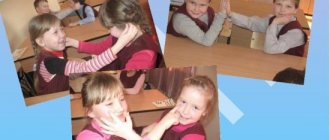Types of violence:
- Physical - corporal punishment, infliction of pain.
- Emotional - from open bullying and bullying to parental manipulation, which is not even recognized as violence (humiliation, comparison, overprotection).
- Sexual.
- Neglect is inaction, improper performance of their duties by parents or guardians. The child is not touched, but is deprived of safety and satisfaction of basic needs: hygiene, comfort, food, etc.
Myth:
violence can only exist in a dysfunctional family; the threat comes only from asocial, marginal people.Reality:
Violence against children exists in many families, in different countries, and is completely independent of the cultural level, ethnicity, education and income of adults.
Myth:
Violence is something scary, but very distant: disadvantaged areas, abandoned places, urban areas where there are almost no people.Reality:
violence is committed where, on the contrary, security should be ensured: family, school, shelter or orphanage.
The essence and causes of violence
The family is the first social institution for a child. This is a place in which he should always feel safe, but sometimes the opposite happens: the family turns out to be the most dangerous place for a child.
Violence is the use of force or psychological attacks on weak and defenseless people (children). But violence can also be inaction, which creates a threat to the physical and mental health of the child. It is doubly dangerous if violence and family are one and the same.
The origin of this phenomenon is usually attributed to the 19th century, when the industrialization of society began, and children began to be exploited, sent to work, deprived of education and prospects. At the same time, the first public organizations began to appear to protect children from violence and exploitation.
In the 20th century, new approaches to studying the problem of violence and abuse of children appeared. The first classifications were compiled. Then violence was divided into pediatric, psychiatric and legal.
The main causes of violence include:
- similar experience in the lives of spouses (model, behavioral stereotype);
- personal experience in the form of suppression in childhood, an authoritative parenting style on the part of the mother (in the future reflected in violence against women, as attempts to break ties with the mother);
- the influence of socio-economic unfavorable conditions, unemployment, low social status;
- dissatisfaction with oneself and life;
- psychopathology;
- deviations and addictions;
- fear;
- inadequate self-affirmation and achievement of power caused by low self-esteem and low self-esteem;
- an unwanted child in the family.
The cause of violence, naturally, lies in the psyche of the parent. The need to find this and work through it is one of the tasks of a psychotherapist when working with a family (the work is carried out not only with the child). Any aggression or violence always has a subjective motive. Another question is that it is not always recognized by the aggressor himself.
Sometimes violence is an attempt to stabilize the state of the family as a system, for example, in the struggle for order or power. Then you need to work with the family as a system and eliminate the causes of its dysfunction. Otherwise, violence will become either chronic or episodic.
Child abuse as a psychological trauma has a number of features:
- Children do not always understand the essence of what is happening;
- if they are aware of the essence, they are not always aware of the true consequences for their physical and mental health;
- events can be forgotten (the children's brain is designed to quickly displace negativity), but make themselves felt in adulthood;
- Children are more likely to tell peers about violence rather than to another family member (if at all).
What to do and where to go for help
You cannot remain indifferent to violence against a child. This applies not only to family members, but also to surrounding people who notice that something wrong is happening with the child. At the first alarm bells, you should seek help from the following authorities:
- local guardianship and trusteeship authorities, whose duties include monitoring the living conditions, education and upbringing of children, as well as representing the interests of minors in court;
- the prosecutor's office is a government body that protects the rights of minors in court, and can also file lawsuits in court for deprivation of parental rights;
- local police department.
Types of violence
Violence can be direct or indirect, isolated or systematic, current or past. But the classification according to the content of violence is more important than others:
- Physical violence. These are any physical acts of violence against a child under 18 years of age, including punishment options (spanking, pushing, grabbing, etc.).
- Neglect of responsibilities. This means failure to comply with parental responsibilities, ignoring the needs of the child, and inadequate care for the child.
- Sexual violence. Using a child under 18 for the purpose of obtaining sexual pleasure. Any erotic contact with or exploitation of a child (pornography).
- Psychological abuse. Humiliation, insults, ridicule and other degrading behavior patterns.
Sexual violence includes several forms:
- Depraved acts. Any actions on the part of an adult that can cause excitement in a child under 14 years of age and form an inadequate attitude towards sexual relations. Actions can be physical (bodily) or intellectual (demonstration of materials).
- Pedophilia. Sexual harassment of a child under 14 years of age.
- Pornography. Any form of demonstration of sexual relations (books, films, magazines).
- Coercion to engage in sexual activity. Not physical, but mental influence on the child, gradually forcing him to enter into some kind of sexual relationship. You can put pressure with the status of an adult, with blackmail.
Child abuse is a general term for any kind of violence. This is actual harm to a child:
- through insults and incorrect punishments;
- inadequate requirements and strict control;
- prohibitions.
Abuse can be called physical actions (beatings), murder, harm due to failure to provide assistance, neglect of a child and his needs, mental harm, lack of protection and care.
The influence of domestic violence on the psychological development of adolescents
Key words: violence, mental violence, social violence, physical violence, adolescents, post-traumatic stress disorder, traumatization.
Violence against children in Russia today is a widespread social phenomenon. In our country, the biggest threat to children is their own families. In the first three months of 2015 alone, according to the Investigative Committee of Russia, the number of teenagers affected by domestic violence increased by one and a half times compared to the entire previous year. Family violence in Russia is systemic in nature, which is expressed in the fact that those who today indulge in acts of violence against children themselves experienced it in childhood. For example, a survey of parents showed that 65.7% of them in childhood were placed in a corner, including in uncomfortable positions, on peas; 45.7% of respondents were subjected to corporal punishment (beating with a belt, heavy objects with mutilation); intimidated (45.7%); punished by deprivation of communication (58.4%). Protecting the rights and dignity of a small child. Coordination of efforts of family and kindergarten [1, p. 2].
And today, children have to experience various forms of domestic coercion and risks of exposure to violent acts, in which rudeness and foul language (40%), psychological pressure (28%), and physical violence (18%) predominate. 6% of children experienced sexual violence in the family. Only 22% of respondents noted that they had not experienced violence, i.e. 78% of children were subjected to violence in one form or another.
Thus, statistical data show the prevalence and severity of the problem of domestic violence in Russia. [10, p. 166]
Modern researchers give different definitions of the terms violence and child abuse, summarizing which we can conclude that violence is various types of behavior - from verbal and emotional abuse, the use of physical force to murder and rape.
It should be noted that violence as a phenomenon of social reality and a subject of scientific research is very difficult to study due to a number of objective and subjective reasons.
There is uncertainty in understanding violence. For example, the definition of child abuse proposed by the World Health Organization in 2003 is too wordy and broad. According to the World Health Organization (WHO), violence is the intentional use of physical force or power, actual or threatened, directed against oneself, another person, a group of people or a community, which results in (or is likely to result in) bodily harm, death, psychological trauma, developmental disabilities or other types of harm. And child abuse is cruel treatment of them, which can be expressed in the form of physical, sexual, emotional abuse or neglect [4, p. 188].
Essentially, this definition includes everything that prevents a child from fully realizing his life and personal potential. This includes the use of physical force against a child, and actions of ignoring and denying the child satisfaction of his basic life needs. It must be said that these actions are very different in nature and impact on the child, and are experienced differently by him.
Also, in a number of documents, the concept of violence is among the concepts that do not require special explanation. Thus, Part 1 of Article 19 of the UN Convention on the Rights of the Child states that state parties must take all necessary measures, including legislative ones, to protect the child from all forms of physical and mental violence, insult or abuse, maltreatment or exploitation. However, this does not reveal the content of the concepts “violence”, “abuse”, “insult”, “exploitation” [15, p. 243].
Such uncertainty makes it difficult to study the problem of child abuse and significantly limits the possibilities of providing interdisciplinary assistance to him.
To conduct research on the problem of violence against children, we propose to adhere to the following definitions of concepts.
Violence against a child is a physical, psychological, social influence on a person (child) from another person (child or adult), family, group or state, forcing him to interrupt a significant activity and perform another that contradicts it, or threatens his physical or psychological health and integrity [3, p. 183].
One type of violence is domestic violence, which can be considered as a complex type of violence. This is a cycle of physical, verbal, emotional, spiritual and economic humiliation and intimidation that repeats with increasing frequency in order to maintain control over the victim. Family violence is a fairly common phenomenon throughout the world and in all segments of the population. We talk about domestic violence in cases where the facts of rough and cruel treatment are not isolated, not random and situational, but regular, systematic and constantly repeated. With all the variety of types of violence, it is characteristic of family violence that it acquires a universal, generalized character. There is no family rapist who would infringe on his victim or victims in one thing [9, p. 165].
In relation to a child, there are four main forms:
- physical,
- sexual,
- mental
- social [5].
K.I. Chudakova points out that physical violence is the deliberate infliction of physical harm on a child, which can cause damage to his health, disrupt his further development and, in extreme cases, take his life [18, p. 162]. Physical abuse also includes introducing a child to the use of drugs, alcohol, poisonous substances or “medicinal” drugs that cause intoxication.
Sexual abuse is when a child is forced, with or without consent, into sexual activities, prostitution and pornography. A child’s consent to sexual contact does not give grounds to consider it non-violent, since the child is not yet able to foresee all the negative consequences of such actions.
Mental violence is a periodic, long-term or constant mental impact on a child, as well as the presentation of demands to the child that do not correspond to his age capabilities, and can inhibit his further personality development and lead to the formation of psychological complexes.
Social violence occurs when the interests and needs of a child are neglected. He is not cared for and his basic needs (food, clothing, shelter, education, medical care) are not met. As a result, the child’s emotional state may be disturbed, and health and normal development may be threatened.
Violence against a child is a field of professional interest in psychology, law and social work. A child who has experienced violence will need specialist help. The violence that a child has experienced may be a hidden reason for the difficulties with which the client turns to a specialist, and also, if you do not seek help in time, this may negatively affect his further development [11, p. 164].
The specificity of the traumatic effect of violence on a child’s psyche is that the perpetrator is a member of the child’s family who commits a cruel act against a specific child with the aim of harming him. Therefore, a child who has been abused becomes a victim in the fullest sense of the word. T. M. Zhuravleva, T. Ya. Safonova, E. I. Tsymbal, X. Vilfing, G. Parens describe the main types and consequences of child abuse, analyze the features of providing psychological and legal assistance to such children.
The vulnerability of adolescents to violence is explained by their physical, mental and social immaturity, as well as their dependent, subordinate position in relation to adults, be they parents, guardians or educators. The psychological and pedagogical literature has accumulated sufficient research experience on this issue [12, p. 183].
Consequently, without understanding the impact that violence has on the psyche of a person, a child, providing assistance to a fairly large category of clients can be difficult [17, p. 67]. The peculiarities of adolescents living with violence are touched upon by such authors as A. Guggenbühl, E. Durkheim, A.H. Buss, D. Olweus and A.N. Drozhevets, who covers the topic of domestic violence in an attempt to answer the question of what mechanisms of coping with a crisis are used by people in an attempt to independently overcome its consequences.
V.V. Korolev notes that the violence that a child has experienced in the family can have a huge impact on the entire further development of the child, and affect not only the emotional, but also the intellectual and behavioral spheres. If a child grows up in unfavorable psychological conditions, then he lags far behind his peers in growth and has delayed psychological development [7, p. 293].
A child who has been subjected to domestic violence may develop an “inferiority complex” and is prone to solitude, fantasies, as well as aggression and antisocial behavior. In this case, aggression can be directed both against others and against oneself.
O. A. Kravtsova points out that adolescents who witness domestic violence are at increased risk of developing emotional and behavioral problems such as anxiety, fear, depression, poor academic performance, low self-esteem, nightmares, and physical illness [8, p. 241].
Almost all teenagers, according to L. S. Andreeva and V. A. Popov, who have suffered from physical violence and neglect, have experienced mental trauma, as a result of which they develop further with certain personal, emotional and behavioral characteristics that negatively affect their future lives [6, p. 65].
Various methods of assistance, rehabilitation and support for adolescents who have experienced domestic violence are discussed by such authors as V. G. Romek, V. A. Kontorovich, E. I. Krukovich, A. G. Osukhova, N. O. Zinovyeva, N. F. Mikhailova, L. R. Aptikieva, V. N. Kurakina.
Cruel treatment of a child, his rejection in a rude or obvious form and the consequences of such an attitude live in the form of psychotraumatic experiences and are transformed first into a victim complex, and then into aggression or auto-aggression.
According to research by E. N. Volkova, the majority of children living in families in which severe physical punishment, emotional or other types of violence are used, have signs of delayed physical and neuropsychic development. Their memory deteriorates: the processes of memorization and storage are difficult, and selectivity in memorization increases sharply. Attention becomes distracted, speech is impoverished, and stuttering often appears. Children perform significantly worse at school, and the processes of school adaptation are more difficult [13, p. 13]. E. V. Burmistrova, A. B. Orlov, N. Yu. Sinyagina, T. Yu. Reifschneider consider this issue from the point of view of preventing crisis situations in the educational environment.
S. B. Nikolaeva notes that regardless of the type and nature of violence, children can experience various diseases that are classified as psychosomatic: obesity or, conversely, sudden weight loss, which is caused by appetite disorders. When physically abused, children develop neuropsychiatric diseases such as tics, stuttering, enuresis (urinary incontinence), encopresis (fecal incontinence), some children are repeatedly admitted to emergency departments due to accidental injuries, poisonings [14, p. 341].
The study by T. Ya. Safonova and E. I. Tsymbal notes that adolescents who have been subjected to various types of violence themselves experience anger, which is most often poured out on the weaker: younger children, on animals [16, p. 82].
In neglected, emotionally deprived teenagers, as N. O. Shvedova points out, the desire to attract attention in any way sometimes manifests itself in the form of defiant, eccentric behavior [19, p. 67].
According to S. B. Nikolaeva, the most universal and severe reaction to any violence is low self-esteem, which contributes to the preservation and consolidation of psychological disorders associated with violence. A person with low self-esteem experiences feelings of guilt and shame. N. V. Tarabrina, E. D. Sokolova, E. O. Lazebnaya, M. E. Zelenova, I. G. Malkina-Pykh, consider domestic violence from the perspective of crisis psychology, namely the subsequent experience of violence as post-traumatic stress disorder (PTSD), i.e. a condition that occurs as a protracted or delayed reaction to situations involving violence, threat to life, disasters, etc.
It is characterized by a constant conviction of one’s own inferiority, that “you are worse than everyone else” [14, p. 200].
As a result, it is difficult for a child to achieve the respect of others, success, and communication with peers is difficult [6, p. 87].
Among these adolescents, even in adulthood, there is a high incidence of depression [14, p. 202].
This manifests itself in attacks of anxiety, unaccountable melancholy, a feeling of loneliness, and sleep disturbances. At older ages, in adolescents, attempts to commit suicide or completed suicides may be observed [10, p. 136].
To summarize all of the above, it can be noted that violence as the deliberate use of physical force or power is not only a significant social problem, but also an issue that requires the professional attention of psychologists and social workers.
Experiences of consequences in adolescents who have been subjected to domestic violence lead to serious difficulties in socialization, development, and preservation of psychological health. As research results show, this group of adolescents has disrupted connections with adults, no appropriate communication skills with peers, due to low self-esteem, the time perspective is also narrowed, semantic connections change, which leads to a threat to health and normal development. Teenagers - victims, usually of physical, social and psychological violence - often find a solution to their problems in a criminal, antisocial environment, and this is often associated with the development of addiction to alcohol, drugs, they begin to steal and commit other criminal acts.
Psychological assistance and rehabilitation of adolescents who have experienced domestic violence, in our opinion, must be carried out through working with the future, building life prospects that allow us to highlight new meaningful connections with others and the world.
Literature:
- Alekseeva, L. S. About violence against children in the family / L. S. Alekseeva // Sociological studies. - 2003. - No. 4. - P.78–85.
- Andreeva, L. S. Features of the personal development of children subjected to cruel treatment in foster families / L. S. Andreeva, V. A. Popov // Young scientist. - 2013. - No. 4. - P. 508–509.
- Volkova, E. N. Psychology of teacher subjectivity / E. N. Volkova. - N. Novgorod, 2001. - 236 p.
- World Health Organization. Violence and its impact on health. World Situation Report. World Health Organization. / Edited by: Etienne G. Krug, Linda L. Dahlberg, James A. Mercy, Anthony B. Zvi and Rafael Lozano. - Geneva: “The Whole World”, 2003. - 372 p.
- Children and violence: Materials of the international seminar “Children’s rights: problems of violence against children.” 02 Dec 2013 / MN.: MTS-Press, 2013. 428 p.
- Enikolopov, S. N. Theories of sexual violence / S. N. Enikolopov, O. A. Kravtsova. - Applied psychology, 2003. - 78 p.
- Korolev, V.V. Violence against internal affairs officers and organized crime / S.N. Korolev // Organized terrorism and organized crime. - 2002. - No. 1. -S. 195–200.
- Kravtsova, O. A. Sexual violence as psychological trauma: diss…. Ph.D. psychol. Sciences: 19.00.01 / O. A. Kravtsova. - Moscow, 2000. - 193 p.
- Malkina-Pykh, I. G. Gender therapy. Handbook of a practical psychologist / I. G. Malkina-Pykh. - M.: Eksmo, 2006. - 371 p.
- Maslova T. R. Punishment of children / T. R. Maslova, M. L. Smagina // Sociological studies. - 2011. - No. 7. - P. 154–161.
- Mugadzhirova A.M. Medical and social problems of women and children subjected to domestic violence / A.M. Mugadzhirova, G.N. Damadanova // News of the DSPU. — 2013. — pp. 45–52.
- Domestic violence: features of psychological rehabilitation, textbook / N. M. Platonov, Yu. P. Platonova.; resp. ed. N. M. Platonov. - St. Petersburg: Rech, 2004. 154 p.
- Violence and child abuse: sources, causes, consequences, solutions: Collective monograph / ed. E. N. Volkova. - N. Novgorod, 2011. 248 p.
- Nikolaeva S. B. Violence against children in the family / S. B. Nikolaeva // Regional Politics. Economy. - 1999. - No. 5. - P. 79–80.
- Problems of violence against children and ways to overcome them / Ed. E. N. Volkova. - St. Petersburg: Peter, 2008. 240 p.
- Safonova T. Ya. Cruelty to children and its consequences / T. Ya. Safonova, E. I. Tsymbal // Cruelty to children: essence, causes, social and legal protection. —1993. — pp. 168–174
- Technologies of social work with various population groups: textbook / resp. ed.P. D. Pavlenka. - M.: INFRA-M, 2009. 272 p.
- Chudakova K.I. Psychosocial work with children subjected to violence. / K.I. Chudakova // VII International Student Electronic Scientific Conference “Student Scientific Forum”. — URL: https://www.scienceforum.ru/2015/1095/10351 (access date: 02/10/2016).
- Shvedova N. O. About violence against women / N. O. Shvedova // Violence and social changes. — 2000 — No. 2–3 — P.38–53.
- Olweus D. Aggression and peer a ceptance in a dolcent boys: Two short-term long it udialstu dieso fratings / D. Olweus/ - Child Developmtnt, 2007. 341 p.
Signs of violence
It is not easy to suspect external violence, which is due to:
- the closeness of the family as a system;
- interdependent relationship between aggressor and victim;
- lack of information;
- intimidation and mistrust on the part of the victim.
Basically it all comes down to the fact that a family where violence reigns is a closed system. But there are a few things that can hint at child abuse:
- screams, claps, slaps, swearing, clearly audible behind the wall (many apartments are separated by thin walls, and violence does not always occur silently);
- traces of beatings on the child;
- the child’s unkempt appearance, clothing inappropriate for the weather.
Signs of physical abuse include:
- damage to body organs and sensory organ disturbances;
- inactivity, lethargy, delayed physical and mental development;
- anxiety and aggression towards other people or animals;
- shyness, passivity, fear of adults;
- avoidance of home, fear of tactile contacts;
- communication with young children.
Signs of psychological abuse include:
- psychotrauma and (or) post-traumatic stress syndrome;
- in children up to middle school age – delay in physical and speech development;
- in adolescents – loss of meaning and purpose in life, disorientation, thoughts of suicide;
- impulsiveness, anger, manipulative disorders (thumb sucking, hair pulling);
- humility and pliability;
- fears and problems with sleep;
- depression and lethargy;
- deviations;
- diseases.
Signs of child sexual abuse:
- the child's age-inappropriate or strange awareness of sexual matters or activities;
- sexual harassment by a child of other children or adults;
- complaints about some health problems, especially in the genital area;
- anxiety when other children cry;
- nervous tics, rocking, thumb sucking.
Common signs of violence:
- the child's inability to concentrate;
- memory impairment;
- self-hatred, lack of self-esteem, low self-esteem;
- pessimism;
- mistrust towards the whole world, especially adults;
- attacks of anger or aggression;
- chronic feelings of fear, shame, guilt;
- detachment from society;
- depression;
- anhedonia.
According to the law of the Russian Federation, a child himself can apply to the guardianship authorities for protection, and from the age of 14 - to the court, but rarely does a child decide to do this. Violence is usually accompanied by intimidation, as well as fear and habituation of the victim.
Each case of violence (cruelty and intensity) is assessed individually. The individual sensitivity of the child, age and the nature of the relationship between him and the adult are taken into account.
The most difficult thing to suspect is psychological violence or violence against the soul of a child. This is a multifaceted category:
- lack of love and attention;
- threats and ridicule;
- inadequate and excessive demands;
- any parental behavior that causes fear in the child;
- prohibitions;
- psychological pressure;
- overprotection;
- manipulation;
- any motives “out of love” that are harmful to the child’s health.
Because of this, low self-esteem, self-doubt, and loss of self-esteem are noted. With overprotection, a feeling of helplessness and complete dependence on parents develops. Separation from the family, social or physical orphanhood of a child forever leaves a mark in the form of a feeling of emotional insecurity. It is not a fact that the consequences will immediately manifest themselves; they may arise years later.
Diseases
One of the consequences of violence against children in the family can be various injuries: fractures, bruises, damage to internal organs, burns. As a result, the child may become disabled or lose his life.
The consequences of sexual violence include damage to the genital organs, sexually transmitted diseases (AIDS, gonorrhea, syphilis, various infections).
The listed forms of violence are often accompanied by emotional and psychological pressure, which can cause problems with the psyche and nervous system. Such children exhibit nervous tics and stuttering.
Weakened by constant stress, the body is susceptible to various infectious and bacterial diseases. Children who have been subjected to violence often suffer from allergies, urinary and fecal incontinence, and respiratory pathologies. As adults, they are more likely to get cancer.
Consequences of violence
A child or adolescent who has experienced violence feels fear, confusion, shame, and powerlessness. He often blames himself and perceives himself as an accomplice and the root cause of what happened. Sometimes he considers his behavior or position in the family to be the reason. Other consequences include a decrease in trust and social circle.
Many reactions depend on the age of the child:
- Children under 3 years old. Popular reactions include: fear, mixed feelings, aggression, loss of appetite.
- Preschoolers. There is anxiety, fearfulness, feelings of guilt and shame, mixed feelings, disgust, and a feeling of helplessness.
- Junior schoolchildren. There is uncertainty among the student in family roles, an ambivalent attitude towards adults, fear, shame, disgust, and distrust of the whole world.
- Younger teenagers. Depression and sensory emptiness (there are no sensations or feelings) are added to the previous consequences.
- Older teenagers. Characterized by disgust, shame, guilt, duality of feelings towards adults, deviant behavior, and a feeling of uselessness.
Sexual violence is especially dangerous when it manifests itself in adulthood:
- psychosomatic diseases;
- lack of acceptance of your body;
- dependent behavior;
- problems in sexual relationships;
- repeated violence (men who have been subjected to violence commit it themselves; women who have been subjected to violence find themselves again in the role of victims).
As the child gets older, there may also be retaliatory violence, loss of self-esteem, mental disorders, and suicide attempts.
Any violence in adult life leaves the following traces:
- violation of self-concept;
- guilt;
- depression;
- sexual dysfunctions;
- problems in interpersonal relationships.
Violation of physical and mental boundaries as a result of violence affects the entire future life and behavior of a person. And the experience is repeated again and again.
In general, three areas of violence can be distinguished in a family: parents against children, adults against adults, and one of the family members against the elderly. And each of these forms is dangerous for the child. If it is not he himself who is subjected to violence, but, for example, his mother, then the following are possible:
- psychoemotional and psychosomatic disorders;
- school maladjustment;
- problems in social adaptation.
Families with violence are always at risk, since such an atmosphere is not suitable for raising a child. Children who grow up in violence, as a rule, later become victims or aggressors themselves (95%).
Why don't adults notice?
Image: Pexels, Kat Smith
- Many adults perceive forms of emotional and physical violence within the confines of the home as a kind of cultural norm: “We were beaten, and that’s okay, but we grew up to be good people. So I’ll make a man out of you.”
- They perceive bullying at school as the norm. “Bullying is normal, it’s a school of life. This is how character is strengthened!”
- Normalization of emotional or family physical (punishment with a belt, etc.) violence in general: “That’s life, you just need to be patient,” “Life is pain. But you will become a real man with me!”
- They are afraid of bad consequences for the offender - a family member. For example, a mother shields a father who beats a child, because “the father is a good person in himself, but life is not kind to him.”
- They feel powerless and therefore are unable to influence the situation, which leads to a crisis of empathy and justification for the aggressor.
- The parent is incompetent in the role of educator (use of “traditional methods of education”), crisis of the parental role, denial of the problem. “I work hard without rest so that you have everything.” As a result, there is money, but no attention.
- Adults are not always ready to think and talk about certain topics and feel helpless in matters of sex education. A child complains that someone squeezed, spanked, stroked him, and adults answer: “It’s okay, don’t make things up, and don’t beat yourself up.”
- Distrust of specialists, unwillingness to wash dirty linen in public. “What happens in the family is no one’s business. We don’t need psychologists and teachers, we can handle it ourselves.”
- Reluctance to interfere (“someone else’s family is in the dark”, etc.).
- Incorrect perception of the characteristics of “adolescence”. An open “help me” manifesto when a child harms himself, posts disturbing posts, starts using, etc.
Diagnosis of violence
It is also difficult to identify violence because parents themselves do not always perceive their actions as violent. They raise their child, yes, using the carrot method without the stick, but this is education. Or the carrot and stick method, then the child takes the beatings for granted for his misdeeds and therefore is even less likely to tell anyone.
There is one more thing that complicates the situation. In fact, any violence is associated with mental violence. Therefore, we have to work with several forms of violence at once.
Physical violence
Diagnostic signs of abuse that can be noted during a conversation with parents:
- nervous behavior;
- a fantastic description of the origins of a child's injuries;
- blaming other people or the child himself;
- multiple contradictions in injury history;
- accusing a child of lying;
- inadequate assessment, expectations and requirements that are not appropriate for the child’s age or developmental level.
Suspicion should be strengthened by the fact that the child is often in the emergency room, repeated similar injuries, and a large time interval between the injuries and going to the hospital.
The problem is that it is possible to notice nonverbal and verbal signs of parents’ lies and resourcefulness only in conditions of close observation and communication. Is this situation available to everyone who cares? No. The neighbor won't be allowed on the threshold of the house. Only social workers can achieve such a meeting with parents. The task of witnesses and eyewitnesses is to facilitate this meeting.
Diagnostic reactions during conversations with children:
- anxiety;
- reluctance and fear of meeting parents;
- the child’s conviction that punishment is justified;
- fear that social workers (defenders) will side with the parents after the conversation and find out that the punishments are justified by the child’s bad behavior;
- crying at any failure;
- tendency to fight;
- flinching at the slightest movement of a hand nearby.
Sometimes it really happens that a child comes up with a story about violence, which may be caused by a need for attention and sympathy, conflicts with friends or in a family rich in imagination. But then the child’s emotional and behavioral reactions will contradict the content of the story. In such cases, fear of parents and other signs and consequences of violence are not noted, but the child’s pleasure in being listened to and enthusiasm for the story is noticeable.
The described signs cannot be regarded separately from the context and family history, but there are a number of diagnostic markers that make it clear about physical abuse:
- bruises, bites, burns, scars;
- signs of suffocation;
- any damage that remains without a clear and correct explanation on the part of the parents;
- low self-esteem of the child;
- reluctance and fear to return home;
- baggy clothes that hide beatings;
- self-accusation of provocations towards the rapist;
- the child perceives beatings as family order and norm;
- excitement, crying, fear during screams, scandals.
Sexual violence
The difficulty in diagnosing sexual violence is that some family members may cover for others, even if the crime is known.
Teenagers react more seriously because they understand what exactly happened to them. As a rule, they change their entire lifestyle, clothing, and environment. Healthy feelings such as empathy and sympathy turn into aggression or blind subordination (to a person, to a cause). Pre-adolescent children show classic signs.
Diagnostic markers of child sexual abuse in the family include:
- good knowledge in matters of sexual relations beyond one's age;
- bruises, itching, blood in the genital area;
- sexual behavioral perversions;
- sudden changes in the child’s behavior;
- change in gait, discomfort when walking and sitting;
- eating disorders;
- self-loathing;
- nightmares and sleep disturbances;
- suicidal tendencies and depression;
- indulgence, compliance in relation to adults;
- deviant behavior.
Neglecting the child's needs
The most common type of violence and the least understood by parents. Even in seemingly prosperous families one can find its elements, for example, a lack of love and attention due to being busy at work.
Therefore, this species is the most controversial in terms of diagnosis. It is customary to judge neglect when there are obvious and serious violations: the child is hungry, poorly dressed, dirty, does not receive medical care or education, is left alone and is in danger.
Deprived children are characterized by promiscuity in building relationships and attempts to attract attention. Other diagnostic markers include:
- pedagogical neglect (small vocabulary, speech problems);
- retardation in physical development;
- unpleasant smell, dirt and hunger;
- depression, passivity and fearfulness;
- stinginess of emotions and poverty of reactions to kindness and praise;
- a feeling of uselessness and the belief “I am not good, I don’t deserve anything, and I will never deserve anything.”
Psychological abuse
The behavior of adults plays a decisive role in diagnosis. Psychological abuse can be suspected if parents:
- they are in no hurry to console the child, communicate with him, or hug him;
- are hypercritical of the child;
- scold, insult, humiliate;
- characterize the child negatively;
- they take out their anger on him on one of his relatives (they associate the child with him);
- openly admit their dislike;
- blame him for their failures.
The child will hint at psychological abuse:
- uncertainty and low self-esteem;
- speech and perception delay;
- tension from anticipation of punishment;
- undeveloped logical thinking;
- disrespect and distrust of adults;
- feigned maturity or independence as a defensive reaction;
- suicidal tendencies.
What to do if you have suspicions? First steps on the road to recovery
If you find out about violent acts against a child, indignation and anger towards him are prohibited! Talk to him carefully, delicately, so that he does not close down and finds the strength to tell what happened.
The teenager can transfer the horror that you demonstrate to himself. The disgust of a loved one will mean only one thing for him - he is disgusting, powerless, guilty of allowing this to happen.
Calm and encourage the child so that he understands: you are not blaming him for anything.
Give gentle feedback: emphasize that this could happen to anyone, “I understand how bad you feel, but together we will get through this.” Experiencing such feelings is an adequate mental reaction. Give the teenager a chance to speak out, do not interrupt him or limit him in time. Tell your child about your actions. If you plan to contact a psychologist, social worker or law enforcement agencies, do not hide it from him.
It is better for a teacher who has identified the fact of violence (or suspects it) to immediately inform the head of the educational institution, orally and in writing.
Rehabilitation
Eliminating violence always requires comprehensive work by a psychologist with parents and children. The most effective methods are:
- psychotherapy;
- individual and group consultations;
- trainings.
When interacting with a child, you must first achieve his favor and trust. To do this, you cannot focus on the situation, that is, say “Don’t be afraid,” “Don’t worry.” The main method of working with a child is a consultation conversation. But only a qualified specialist can carry it out.
Violence is always a stressful situation for a child, leading to psychological trauma. Accordingly, work should be aimed at eliminating psychotrauma and post-traumatic stress disorder, if it is observed. The best method is psychotherapy.
What should parents do?
“The best way to make children good is to make them happy” Oscar Wilde. Wonderful, smart, healthy and developed children in every sense of the word grow up only in love. A child should be loved not because he is neat, calm, beautiful, flexible, and so on, but because he is! Of course, there is no education without punishment, but you need to correctly and competently guide your blood through life. Warn about dangers, talk about all the topics that concern him, and not refer to being busy. Share your own impressions and opinions, suggest what to do in a given situation. Allow him to make his own mistakes, otherwise his character will not develop, do not shut his mouth and, especially, do not yell or put pressure on him with authority. This does not mean being on an equal footing and indulging in every whim. This means recognizing the dignity and importance of a little person, respecting him and accepting him for who he is, slightly and unobtrusively correcting some shortcomings that are likely to hinder him in later life.
Prevention of violence
The main directions of prevention: education and information. They should be carried out in relation to children, parents, employees of child care institutions and all citizens in general. It is important to say:
- about what violence is;
- about its types;
- what to do if you become a witness or victim of violence;
- what is the responsibility for violence;
- where you can report violence (organizations, telephone numbers).
You should not talk in the context of “how to avoid becoming a victim of violence,” as this immediately sets the stage for self-accusation. As stated in the article, victims already tend to look within themselves for the reason, but this is not the case.
Problems with socialization
Children who have experienced violence experience enormous difficulties in social adaptation; it is difficult for them to find a common language with their peers. They often have problems with alcohol and drugs, with the help of which they find peace. Girls tend to engage in prostitution, and boys have disturbed sexual orientation.
It is difficult for such children to create their own families. They often transfer their experiences onto their own children, becoming aggressors. Therefore, the cycle of domestic violence continues from generation to generation.











